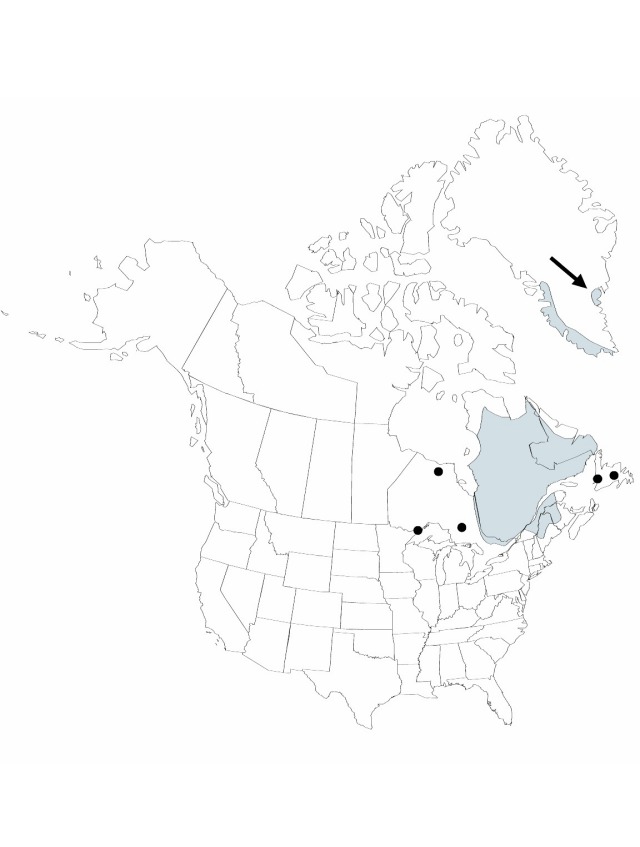Difference between revisions of "Juncus subtilis"
Syn. Luzul. 31. 1823.
FNA>Volume Importer |
imported>Volume Importer |
||
| (6 intermediate revisions by 2 users not shown) | |||
| Line 8: | Line 8: | ||
}} | }} | ||
|common_names=Creeping rush;jonc délié | |common_names=Creeping rush;jonc délié | ||
| + | |special_status={{Treatment/ID/Special_status | ||
| + | |code=E | ||
| + | |label=Endemic | ||
| + | }} | ||
|basionyms= | |basionyms= | ||
|synonyms={{Treatment/ID/Synonym | |synonyms={{Treatment/ID/Synonym | ||
|name=Juncus uliginosus var. subtilis | |name=Juncus uliginosus var. subtilis | ||
|authority=(E. Meyer) Hooker | |authority=(E. Meyer) Hooker | ||
| − | }}{{Treatment/ID/Synonym | + | |rank=variety |
| + | }} {{Treatment/ID/Synonym | ||
|name=Juncus pelocarpus var. subtilis | |name=Juncus pelocarpus var. subtilis | ||
|authority=(E. Meyer) Engelmann | |authority=(E. Meyer) Engelmann | ||
| − | }}{{Treatment/ID/Synonym | + | |rank=variety |
| + | }} {{Treatment/ID/Synonym | ||
|name=Juncus pelocarpus var. fluitans | |name=Juncus pelocarpus var. fluitans | ||
|authority=(Michaux) Buchenau | |authority=(Michaux) Buchenau | ||
| + | |rank=variety | ||
}} | }} | ||
|hierarchy=Juncaceae;Juncus;Juncus subg. Septati;Juncus subtilis | |hierarchy=Juncaceae;Juncus;Juncus subg. Septati;Juncus subtilis | ||
| Line 42: | Line 49: | ||
-->{{#Taxon: | -->{{#Taxon: | ||
name=Juncus subtilis | name=Juncus subtilis | ||
| − | |||
|authority=E. Meyer | |authority=E. Meyer | ||
|rank=species | |rank=species | ||
| Line 56: | Line 62: | ||
|publication title=Syn. Luzul. | |publication title=Syn. Luzul. | ||
|publication year=1823 | |publication year=1823 | ||
| − | |special status= | + | |special status=Endemic |
| − | |source xml=https:// | + | |source xml=https://bitbucket.org/aafc-mbb/fna-data-curation/src/2e0870ddd59836b60bcf96646a41e87ea5a5943a/coarse_grained_fna_xml/V22/V22_230.xml |
|genus=Juncus | |genus=Juncus | ||
|subgenus=Juncus subg. Septati | |subgenus=Juncus subg. Septati | ||
Latest revision as of 20:30, 5 November 2020
Herbs, perennial, emergent, rhizomatous (forming mats to 5 dm), 0.5–1 dm. Rhizomes 1 mm diam., nodes not swollen. Culms repent, floating or submersed, usually profusely branched, terete, 0.5–1 mm diam. Cataphylls absent. Leaves: basal 1–5, cauline 1–4, small fascicles of short capillary leaves often on rhizomes and stems; auricles 0.1–0.8 mm, apex acute, membranaceous; blade terete, 1.6–3 cm × 0.1–0.3 mm. Inflorescences cymes, flowers 1–3 at 1–2 nodes, 1–4 cm, branches spreading to erect. Flowers: tepals reddish, oblong; outer tepals 1.8–2.8 mm, obtuse; inner tepals 2.2–4.4 mm, obtuse; stamens 6, anthers 3/4 to equal filament length. Capsules exserted, chestnut brown, 1-locular, ovoid to narrowly ovoid, 2.4–5 mm, apex acute proximal to beak, valves separating at dehiscence. Seeds ovoid, 0.3–0.5 mm, not tailed; body clear yellow-brown. 2n = 40.
Phenology: Fruiting late summer–early fall.
Habitat: Muddy, sandy or gravelly shores, fens in decomposed peat, fine muds rich in humus, and submersed in brackish pools
Elevation: 0–200 m
Distribution

Greenland, N.B., Nfld. and Labr., Ont., Que., Maine.
Discussion
Flowers are rarely replaced by bulbils. Most Greenland collections are sterile.
Selected References
None.